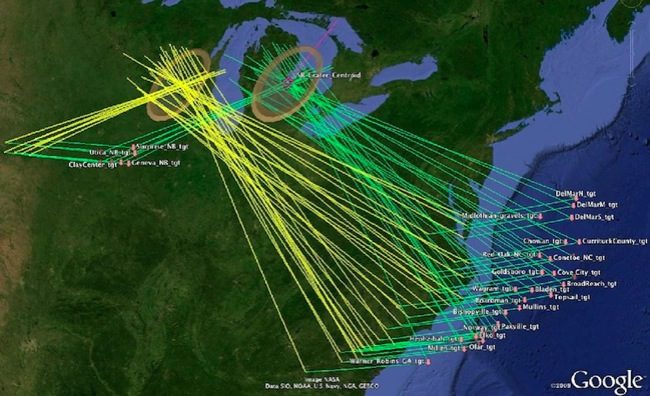Zamora builds on the modern work of Davias and David Kimbel, and Willam Prouty and Melton and Schriver of the first half of the 20th century, with an assist from Eyton and Parkhurst in the 70's. Each of the researchers maintained that the bays were formed at once by a barrage of material from the midwest. But, just as the early researchers ultimately decided, those alive today dismiss bays as direct impacts of ET fragments of a comet or asteroid, and consider them to be the remnant features of secondary impacts from the ejecta and ballistic shockwaves of northerly catastrophe. They are wise to do so. The correct theory must account for ALL the easily observed, unique characteristics of bays. [See list of 16 from Eyton and Parkhurst here] The "wind and wave," gradual formation, theories that continue to hold sway in classrooms and publications from Ivestor and Brooks fail miserably to account for all the observed phenomena, while Zamora checks each off with ease.
Zamora's work, like Davias, is multidisciplinary and assisted by geometry as well as geology. Here is a sample:
Ellipses are mathematical conic sections formed by the intersection of a plane and a cone. The elliptical geomorphology of the Carolina Bays and the Nebraska Rainwater Basins can be explained if the bays originated from slanted conical cavities that were later remodeled into shallow depressions by geological processes. A width-to-length ratio of 0.58 corresponds to a cone inclined at 35° using the relationship sin(θ) = W/L. The proposed conical cavities could have been made by impacts of material ejected at approximately 35° in ballistic trajectories from the point of convergence in the Great Lakes Region. The small variations of the width-to-length ratio correspond to slightly different angles that are consistent with possible ballistic trajectoriesThe bays rims to Zamora are the result of a complex mathematical equation. They are the final surface expression of thousands of conical, inclined ballistic shock cones, each traveling with a giant ice fragment blown from the ice sheet in a nine-minute supersonic arc from the frigid north to the Carolina coast. (I will work on that sentence but you get the idea). These icebergs from space slammed into the supersaturated unconsolidated sandy clays of the coastal plain and left behind shock "ripples" and "flaps" we recognize today as bay rims. Zamora even provides an equation relating the perfection and ellipticity of bays to the degree of unconsolidated sediments encountered by the ice bullets:
The LiDAR images also reveal that some terrains do not have elliptical bays. Davias and Harris (2015) describe six archetype bay shapes that may be determined by the geological characteristics of the terrain. The thickness of the layer of unconsolidated material required to produce an elliptical bay can be estimated by the formula tan(θ) × L/2, where L is the length of the major axis and θ is the angle of inclination. A conical cavity inclined at 35° corresponding to a bay with a major axis of 400 m would require a layer of unconsolidated material with a depth of approximately 140 m.That makes sense to me, and accounts for the "classes" of similar bays, an aspect unexplained by wind and water enthusiasts, but first investigated by Davias.
In addition to the present journal publication, Zamora makes his case in detail in a recently published book available from Amazon: Killer Comet: What the Carolina Bays tell us. I am reading it now and will update this post accordingly.
On the shoulders of genius, Zamora has provided defensible and superior answers to the many questions provoked by the appearance and distribution of Carolina bays. The geological community will largely ignore this paper, of course, but some will take note. And there is always reason for hope as the class of geologists who reject recent catastrophic explanations out-of-hand continue their long march from the tenured defense of the known, to retirement, and finally to death. I note that in closing Zamora gives a shout-out to one of his peer reviewers, Professor Andrew J. Plater of the University of Liverpool, clearly an enlightened young man, who tweets here as @GeomorphologyDr if you want to thank him.




T hank you SOTT for posting this. A good article presenting a more reasonable explanation for the formation of the 'Bays' than many put forward to date. Did you know that the Venus Flytrap plant is only found in a couple of the Carolina Bays? [Link] No where else in the world. Panspermia in action.